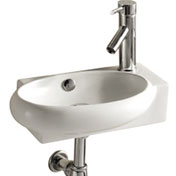Small Ceramic Basins
Ceramic basins are basins that can be used for a long period of time. These basins can resist hot and cold temperatures and are very cost-effective. They are made of a combination of fillers, clays, and fluxes that are fused together during the process of firing. Small ceramic basins are easy to maintain and clean. They have smooth surfaces and come in attractive colors and shapes. The good thing about ceramic basins is that they do not rust or corrode, unlike the cast iron-coated enamel basin.
Ceramic versus Vitreous China Basins
Given the number of materials used for basins, you might find it difficult to decide which one to buy. Some people have the dilemma of choosing between small ceramic basins and vitreous china basins. Vitreous china is actually a type of ceramic; it uses a finer grade of clay and high temperature is used for firing it. While the materials and process used to make a vitreous china basin inevitably make it more durable, it is also much thicker than a regular ceramic basin. They are both painted before being fired but china uses a smoother grade of paint, resulting to the end product being glossier.
Care for both types of sinks are similar and are typically germ-resistant, non-porous, and do not rust. The price difference can be huge because vitreous china is a made-to-order product while ceramic basins are commercially available in most hardware stores.
Ceramic Basins for the Kitchen
The most common kitchen basin is called the Butler’s sink. This is a rectangular-shaped basin that is set into a work surface. It has a rounded rim and is much deeper than most basins.
There are two types of Butler’s sink: the London sink and the Belfast sink. The London sink used to be shallower than the latter but nowadays however, they are both shallow. Also, the Belfast sink comes with a fitted overflow weir. This weir prevents the water from spilling over the rim by draining it automatically into the plumbing. The choice of ceramic basins for the kitchen often depends on the house’s design. Ceramic basins give off a conservative look and are great for traditional kitchens. Self-rimming and undermount ceramic kitchen basins are also available.
Making Your Own Ceramic Basin
If you are a potter or you know how to do the job, you can make your own small ceramic basins for your home. You will need twelve pounds of clay to begin with and form it using a potter’s wheel. After forming the sink, you will have to put it under a firing process twice. It may take you several tries before you are satisfied with the basin so it’s best to make more than one. It is also important to remember that the higher the temperature of the oven, the more resistant the ceramic is to fading, staining, and scratching. But if you are not capable of working on a large piece of clay, it’s better if you purchase the basin instead. After all, ceramic basins are not that expensive, unlike granite or copper.

